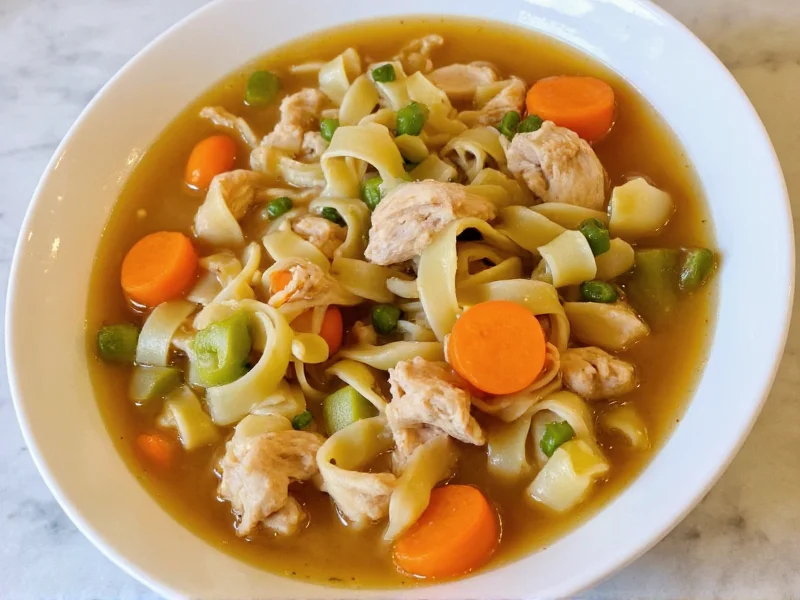When you're craving authentic comfort food that warms you from the inside out, few dishes compare to a well-made chunky chicken noodle soup. This beloved variation elevates the traditional recipe by emphasizing hearty portions of each component, transforming a simple soup into a complete meal that satisfies both hunger and nostalgia.
What Makes Soup 'Chunky'?
The distinction between regular and chunky chicken noodle soup lies in ingredient proportions and preparation techniques. While standard versions might feature finely diced components, chunky variations showcase:
- Generous 1-1.5 inch chicken pieces instead of shredded or minced
- Substantial vegetable chunks (carrots, celery, onions) that maintain texture
- Thicker noodles that hold their shape during cooking
- A broth-to-solid ratio favoring visible, hearty components
Understanding these characteristics is essential when preparing homemade chunky chicken noodle soup recipe that delivers on its promise of heartiness.
Essential Ingredients for Authentic Chunky Chicken Noodle Soup
Creating the perfect bowl requires careful selection of ingredients. For the best results when making chunky chicken noodle soup from scratch, prioritize these elements:
| Ingredient Category | Recommended Choices | Avoid |
|---|---|---|
| Chicken | Bone-in thighs or drumettes (for flavor), breast meat cut into 1" cubes | Pre-cooked shredded chicken (lacks depth) |
| Noodles | Extra egg noodles, wide egg noodles, or artisanal pasta shapes | Thin vermicelli or overprocessed pasta |
| Vegetables | Fresh carrots, celery, onions cut into 3/4" pieces | Canned vegetables or pre-diced mixes |
| Broth | Homemade bone broth or high-quality low-sodium store brand | Regular sodium broth (overwhelming when reduced) |
Step-by-Step Preparation Guide
Follow these detailed instructions for the best chunky chicken noodle soup with vegetables that maintains perfect texture throughout:
- Build flavor foundation: Sauté onions, carrots, and celery in olive oil until softened but not browned (8-10 minutes)
- Create rich broth: Add chicken bones (if using), broth, herbs, and simmer 20 minutes to extract maximum flavor
- Add chicken: Incorporate cubed chicken breast and simmer gently until cooked through (12-15 minutes)
- Perfect noodle timing: Add noodles during the last 8-10 minutes of cooking to prevent mushiness
- Final seasoning: Adjust salt, pepper, and herbs after all components are cooked
Pro tip: For thick chunky chicken noodle soup variations that maintain separation between components, cook noodles separately and add them to individual bowls when serving. This prevents the noodles from absorbing too much broth during storage.
Avoiding Common Preparation Mistakes
Even experienced cooks encounter challenges with chunky chicken noodle soup cooking time and technique. Steer clear of these frequent errors:
- Overcooking noodles: Adding them too early results in mushy texture. Cook separately if preparing in advance.
- Using low-quality broth: The broth forms 70% of your flavor profile—never compromise here.
- Insufficient vegetable size: For true chunkiness, cut vegetables larger than you initially think necessary.
- Skipping the resting period: Let soup sit 15 minutes after cooking for flavors to meld properly.
Delicious Variations to Try
Once you've mastered the basic recipe, experiment with these popular healthy chunky chicken noodle soup with vegetables adaptations:
- Herb-Infused: Add fresh thyme, rosemary, and parsley during the last 5 minutes of cooking
- Spicy Kick: Include a pinch of red pepper flakes or dash of hot sauce for depth
- Gluten-Free: Substitute regular noodles with high-quality gluten-free alternatives
- Extra Hearty: Incorporate white beans or diced potatoes for additional substance
Proper Storage and Reheating Techniques
Chunky chicken noodle soup storage tips are crucial for maintaining quality between servings. Follow these guidelines:
- Cool soup completely before refrigerating (within 2 hours of cooking)
- Store broth and noodles separately if possible to prevent sogginess
- Refrigerate for up to 4 days or freeze for 3 months
- When reheating, add a splash of broth or water to restore ideal consistency
- Never microwave frozen soup—thaw in refrigerator first
Remember that chunky preparations often hold up better during storage than finely diced versions, as the larger components maintain their integrity through multiple heating cycles.
Why Chunky Soup Deserves a Place in Your Recipe Collection
Beyond its comforting qualities, a well-prepared chunky chicken noodle soup offers practical advantages:
- Serves as a complete meal with balanced protein, vegetables, and carbohydrates
- Provides hydration benefits while delivering substantial nutrition
- Adaptable for various dietary needs with simple ingredient swaps
- Creates minimal food waste with versatile leftovers
- Offers therapeutic benefits during cold weather or when feeling under the weather
Whether you're preparing it for a family dinner, meal prepping for the week, or bringing comfort to someone who's ill, understanding how to make chunky chicken noodle soup from scratch ensures you can create this timeless dish with confidence and consistency.











 浙公网安备
33010002000092号
浙公网安备
33010002000092号 浙B2-20120091-4
浙B2-20120091-4